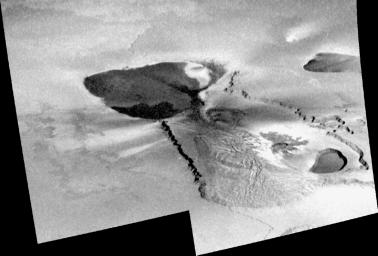
|
Galileo’s Last View of Tvashtar, Io
- Click the image above for a larger view
- Full-Res JPEG (1280 x 866) (149.2 kB)
- Full-Res TIFF (1280 x 866) (381.9 kB)
Caption:
This mosaic of Tvashtar Catena on Jupiter's moon Io, taken by NASA's Galileo spacecraft on Oct. 16, 2001, completes a series of views depicting changes in the region over a period of nearly two years. A catena is a chain of volcanic craters.
Streaks of light and dark deposits that radiate from the central volcanic crater, or "patera," are remnants of a tall plume that was seen erupting in earlier images.
This image and the others from November 1999, February 2000 , December 2000 , and August 2001 were all taken to study aspects of this ever-changing, extremely active volcanic field.
Tvashtar is pictured here just 10 months after both the Galileo and Cassini spacecraft observed the eruption of a giant plume of volcanic gas emanating from it. The plume rose 385 kilometers (239 miles) high and blanketed terrain as far as 700 kilometers (435 miles) from its center.
Tvashtar has erupted in a variety of styles over the course of almost two years: (1) a lava curtain 50 kilometers (30 miles) long in the center patera, (2) a giant lava flow or lava lake eruption in the giant patera at far left, and (3) the large plume eruption . Therefore Galileo scientists expected that the lava flow margins or patera boundaries within Tvashtar would have changed drastically. However, the series of observations revealed little modification of this sort, suggesting that the intense eruptions at Tvashtar are confined by the local topography.
North is to the top of the mosaic, which is approximately 300 kilometers(186 miles) across and has a resolution of 200 meters (656 feet) per picture element.
Background Info:
The Jet Propulsion Laboratory, a division of the California Institute of Technology in Pasadena, manages the Galileo mission for NASA's Office of Space Science, Washington, D.C. Additional information about Galileo and its discoveries is available on the Galileo mission home page at http://galileo.jpl.nasa.gov . Background information and educational context for the images can be found at http://solarsystem.nasa.gov/galileo/gallery/index.cfm .
Cataloging Keywords:
| Name | Value | Additional Values |
|---|---|---|
| Target | Io | |
| System | Jupiter | |
| Target Type | Satellite | |
| Mission | Galileo | Cassini-Huygens |
| Instrument Host | Galileo Orbiter | |
| Host Type | Orbiter | |
| Instrument | Solid-State Imaging (SSI) | |
| Detector | ||
| Extra Keywords | Crater, Grayscale, Plume, Volcano | |
| Acquisition Date | ||
| Release Date | 2002-05-28 | |
| Date in Caption | 2001-10-16 | |
| Image Credit | NASA/JPL/University of Arizona | |
| Source | photojournal.jpl.nasa.gov/catalog/PIA03529 | |
| Identifier | PIA03529 | |
